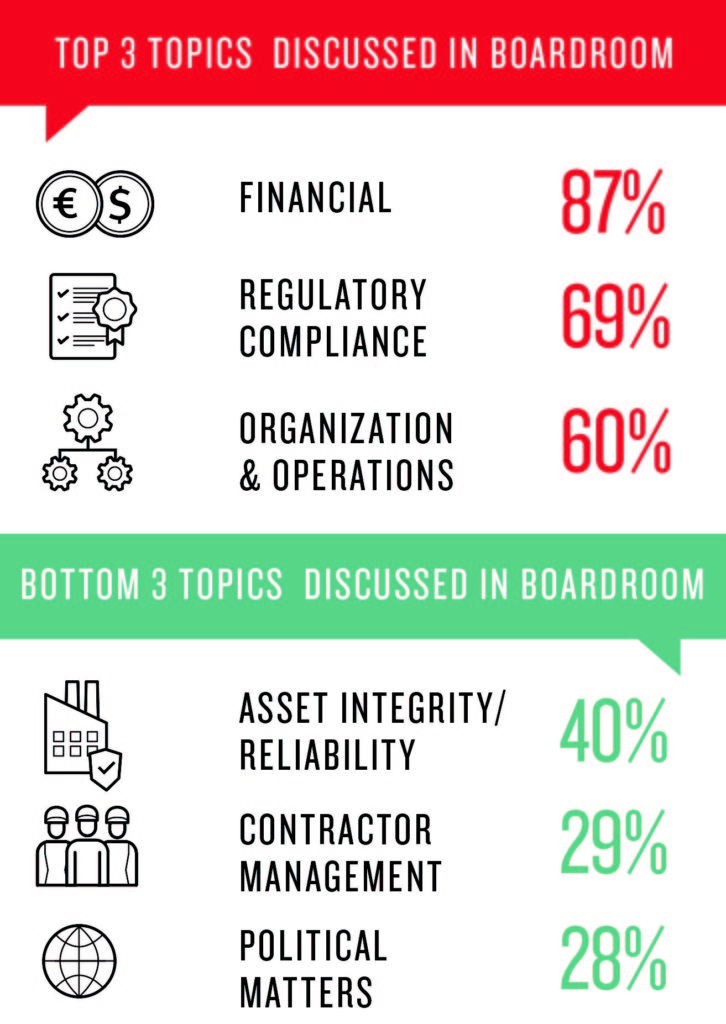Risk Management
DuPont Risk Management Survey: How to avoid the nose dive – the risks most businesses are not aware of
The results the DuPont Sustainable Solutions Operations Risk Management Survey 2018, discussed by Nicholas Bahr, Global Practice Leader for Operational Risk Management.

The average length of time companies manage to maintain a foothold on the S&P 500 has been steadily declining, from 37 years in 1980 to 24 years in 2016. By 2027, predictions claim most will only last for 12 years[i]. Profitability, agility, adaptability are all key to staying in the game, but unexpected disasters caused by risks that were not deflected in time don’t help. Just think of the issues Boeing faces as a result of the Boeing 737 max 8 crashes. The risks posed by the introduction of new technology, a flood of data, complex international supply chains, ageing assets, natural disasters, trade wars, price pressure on commodities and raw materials and cybercrime are all ignored at their peril.

Nick Bahr
Yet the recently published results of the 2018 DuPont Sustainable Solutions Global Operational Risk Management survey show that many executives fail to prepare sufficiently for potentially devastating risks because falling or low Lost Time Injury (LTI) rates give them a false sense of security. Two thirds of the survey respondents in fact admitted to feeling safe when they saw data indicating low incident rates or figures trending towards zero. This, despite the fact that 78% agreed that low incident rates do not correlate to reduced risk.
This is unfortunately repeatedly corroborated by industrial incidents. Last year, Apple had to stop production of its iPhone 8 for around two weeks when it discovered that unauthorised components had somehow got into the supply chain. A major fire at an automotive industry supplier in May 2018 significantly interrupted production at General Motors, Fiat Chrysler and Mercedes-Benz. It also forced the Ford Motor Co. temporarily to lay off 3,600 employees and suspend production. Neither the fire nor the unsanctioned iPhone components were predictable from tracked LTI rates.
While employee safety is of course important, a narrow focus solely on incident rates and other lagging indicators fails to take into account and prepare for longer-term risks that may threaten an organisation’s future. The survey findings nonetheless show that many of the executives questioned, particularly those at Board of Director and Executive Committee level, are not looking at leading indicators of future risks but instead use lagging indicators to assess how they did in the last quarter or financial year. At boardroom level, leading indicators such as asset reliability, supply chain integrity and process safety are still the least discussed topics. Without a forward-looking, long term risk management strategy, however, most executives fail to address potentially looming big accidents. If Dreamworld, for example, had better heeded its near misses and taken them as early warning signs, might the devastating events on the Thunder River Rapids ride in October 2016 have been prevented? A more holistic risk assessment and management approach that looks further than the next quarter would give senior managers, shareholders and investors all a more realistic idea of long-term risk.
 A jungle of processes
A jungle of processes
So if executives are not developing long-term risk management strategies, what are they doing to prevent threats to their operations? The answer appears to be that they are adding more processes. 44% of survey participants admit to gaps in their existing risk management systems and say that they pose a challenge for their organisation. In an attempt to fix this and achieve better performance, they expand existing or introduce new processes. That however contradicts another outcome of the survey in which 82% of executives acknowledge that processes and systems alone are not enough to manage risk and safeguard operational and business performance. In fact, adding new procedure on top of procedure increases operational complexity, which not only adds risk to the company, but is unsustainable to the organization over the long term. CEOs around the world have told us many times that their main concern is that their operations are too complex. The fact, that many of them are adding rather than simplifying processes could be interpreted as a lack for better ideas of how to deal with risk.
A gulf that needs to be bridged
Like the previous DuPont Sustainable Solutions operations risk management survey, the 2018 findings again showed that there is also still a large disconnect between the boardroom and the shopfloor when it comes to managing risk. BT was fined just last year for putting the public at risk during streetworks in London. During sentencing, the judge highlighted the “clear disconnect between BT and its contractors” which consistently led to safety breaches.
Although the vast majority of the executives interviewed for the survey (83%) know they need to influence the hearts and minds of workers if they want to achieve and maintain a good operational performance – in other words maximise efficiency and minimise losses – only 11% feel they are actually achieving this. Small wonder that a quarter of the survey respondents therefore believe front-line staff are not aligned with leadership on the top risks facing the organisation. In fact, more than half (55%) admit that even senior leadership is misaligned on risk management. While executives do not fully understand the risks that exist on the shop floor or on the processing line, employees conversely do not have a complete picture of the overall risks that threaten the operation of the entire organisation. Clearly, business leaders must do more to promote two-way communication and engagement between management and front-line staff. This would help them to identify and prioritise potential weaknesses and threats, as well as develop strategies that can effectively reduce risk.
Looking at the bigger picture
The executives who took part in the 2018 DSS global operations risk management survey clearly want to reduce the risks facing their organisations, but they also largely admit to not managing those risks entirely effectively. A more holistic approach across the entire value chain that clearly identifies, addresses and tracks risks and integrates risk management into key functions would serve them better and should allow them to:
- Identify potential threats and vulnerabilities;
- Prioritise the organisation’s risk focus in line with its business profile;
- Develop strategies to mitigate risks and build capabilities;
- Eliminate silos and ensure risk management is part of key functions in the organisation;
- Ensure the continued validity and effectiveness of risk management elements through regular reviews.
By increasing their awareness of long-term risks and implementing a holistic operational risk management programme, company executives should be able to mitigate the many risks that threaten business continuity and performance, enhance the resilience of their organisation and improve decision-making processes to ensure they keep their organisations safe and profitable.
The DuPont Sustainable Solutions Operations Risk Management Survey 2018 was conducted among leaders of more than 350 companies around the world from a wide range of industry sectors. High hazard industries such as mining & metals, oil & gas were represented, as were companies with complex value chains like petrochemicals, food & beverage and manufacturing, and organisations that work with the general public from transportation to utilities and healthcare. Roughly two-thirds of the companies have a global presence, while the remainder are only active in their region. Nearly half (46%) of the companies surveyed have a workforce consisting of more than 20% contractors.
[i] 2018 Corporate Longevity Forecast: Creative Destruction is Accelerating,” Innosight, February 2018
DuPont Risk Management Survey: How to avoid the nose dive – the risks most businesses are not aware of
The results the DuPont Sustainable Solutions Operations Risk Management Survey 2018.
Safety & Health Practitioner
SHP - Health and Safety News, Legislation, PPE, CPD and Resources Related Topics
Legionella Management: Who can be appointed as RP, DRP, AP or CP?
James Macpherson on risk: ‘More of the same won’t work’
SHP’s Most Influential in Health & Safety Winner: Steve Harris on the importance of being a values-driven OSH professional



 A jungle of processes
A jungle of processes
It is evident that leading/lagging indicators in relation to health and safety weren’t going to pick up issues in terms of Apple, nor Mercedes’ supplier, so the point is what? If we talk about ISO45001 or its predecessor, then we aren’t looking at supply chain management, however, if we are to look at the standard, it is about understanding the context element of the organisation and the risks and opportunities that it poses. There is a need for leadership to be audited, understand their own organisation’s context, ensure that the relevant resources are embedded within the organisation. It is no… Read more »
Therein lies the expediency of sustaining deniability and narrowing what you look at as, if like the HSL you ignore the outcomes of the HSE Better Display Screen RR 561 2007 medical review findings that the UK DSE Regulations have done little or nothing to reduce eye-strain directly linked to sub-optimal screen interface ergonomics and/or the visual repetitive stress injuries presenting in binocular disruptions to 58% of DSE operator founded in over-exposure, fatigue, presenteeism and deficits in 3D Safety due to asthenopia, now a Global Pandemic scaled by the WHO in it’s International Classification of Diseases, then you do not… Read more »
Firstly, I agree that incident statistics give a false sense of security, and I go further to say that they are not even a measure of safety performance. Gaps in safety management systems are often the result of rigidly implementing Standards e.g. ISO 45001. Organizations do only what is necessary to get the certificate and resolve non-conformities by adding new procedures. The gaps in understanding (and hence managing) risks between top management and shop floor are a result of ineffective hierarchical structures. What the article describes as a holistic approach, can be enacted by designing communication and controls in a… Read more »
Interesting article, no question with the point that the lagging metrics are almost irrelevant here. The issue seems to me to be characterised by senior leaders unable to recognise that there are H&S dimensions to all their decision making – to a greater or lesser extent depending upon what the decision is about. You see this kind of miss all the time – from decisions about acquisitions to decisions about cost cutting in operational activities. Why do they miss this stuff? Because they don’t know what they don’t know and generally have no-one in the business with some safety insight… Read more »